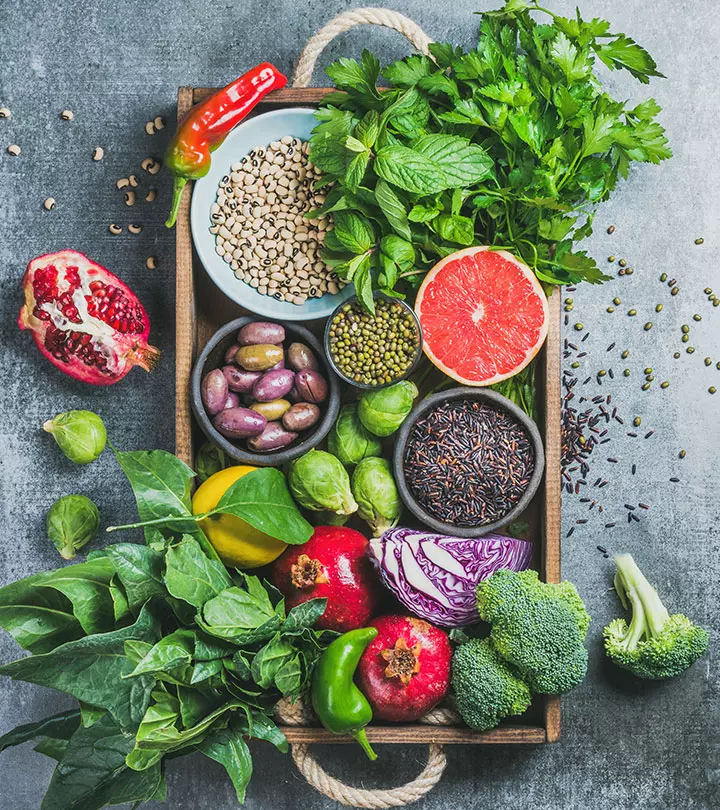Foods Rich In Calcium: 7 Groups To Boost Bone Health
Discover essential nutrient sources to strengthen bones and enhance your wellness daily.

Image: Shutterstock
Including foods rich in calcium in your diet not only makes your bones stronger but also helps in muscle contraction and relaxation while you exercise. It also helps in reflex signaling and many other vital functions of the body.
The foods listed in the article below are loaded with calcium. Choose your favorites from them and boost your calcium levels. Scroll down to check them out!
In This Article
Why Do You Need Calcium?
Calcium sustains the entire skeletal system and muscles, supports the functioning of the nervous system, and is an essential component of the circulatory system (1).
Without it, fat-soluble nutrients like vitamins A, D, E, and K do not get assimilated in your body. This imbalance can trigger a chain of disorders and deficiencies (1).
Read on to find a list of calcium-rich food groups.
7 Food Groups That Are Rich In Calcium
1. Vegetables
| Vegetable | Serving Size | Calcium Content (in mg) |
|---|---|---|
| Collard greens, cooked | ½ cup | 178 |
| Wasabi | 1 cup | 166 |
| Spinach | ½ cup | 146 |
| Turnip greens, fresh, cooked | ½ cup | 124 |
| Kale, fresh, cooked | 1 cup | 94 |
| Okra, cooked | ½ cup | 88 |
| Beet greens, cooked | ½ cup | 82 |
| Chinese cabbage (bok choy) | 1 cup | 79 |
| Broccoli | 1 cup | 42.8 |
| Cabbages | 1 cup | 35.6 |
| Horseradish | 1 cup | 30 |
| Radish | 1 cup | 29.0 |
| Cauliflower | 1 cup | 22.0 |
2. Fruits, Juices, And Dried Fruits
| Fruit | Serving Size | Calcium Content (in mg) |
|---|---|---|
| Orange juice (fortified with calcium and vitamin-D) | 100 g | 201 |
| Rhubarb, frozen, uncooked | 100 g | 194 |
| Figs (dried) | 100 g | 162 |
| Curranta, zante, dried | 100 g | 86 |
| Prunes, dehydrated, uncooked | 100 | 72 |
| Oranges with peel | 100 | 70 |
| Dates, medjool | 100 | 64 |
| Apricots, dried, uncooked | 100 | 55 |
| Raisins, seedless | 100 | 50 |
| Mulberries | 100 | 39 |
| Elderberries | 100 | 38 |
| Jackfruit | 100 | 34 |
| Lychees, dried | 100 | 33 |
| Blackberries | 100 | 29 |
| Kiwifruit | 100 | 26 |
| Raspberries | 100 | 25 |
| Papayas | 100 | 24 |
Source: (3)
3. Dairy And Milk Products
| Dairy/Milk Product | Serving Size | Calcium Content (in mg) |
|---|---|---|
| Whey, sweet, dried | 100 g | 796 |
| Romano cheese | 1.5 oz | 452 |
| Yogurt, plain, low-fat | 8 oz. | 415 |
| Swiss cheese | 1.5 oz. | 336 |
| Mozzarella | 1.5 oz | 333 |
| Cheddar cheese | 1.5 oz. | 307 |
| Milk, non-fat | 8 oz. | 299 |
| Buttermilk, low-fat | 8 oz. | 284 |
| Whole milk (3.25% fat) | 8 oz. | 276 |
| Feta cheese | 1.5 oz | 210 |
| Cottage cheese, 1% milkfat | 1 cup | 138 |
| Frozen yogurt, vanilla | ½ cup | 103 |
| Ice cream, vanilla, | ½ cup | 84 |
| Sour cream, reduced fat | 2 tablespoons | 31 |
| Cream cheese, regular | 1 tablespoon | 14 |
4. Legumes, Legume Products, And Lentils
| Legume/Lentil | Serving Size | Calcium Content (in mg) |
|---|---|---|
| Winged beans, mature | 100 g | 440 |
| Soymilk, calcium- fortified | 8 oz. | 299 |
| Tofu, firm, with calcium sulfate | ½ cup | 253 |
| Tofu, soft, with calcium sulfate | ½ cup | 138 |
| Soy meal, defatted, raw | 100 g | 244 |
| White beans, mature | 100 g | 240 |
| Natto | 100 g | 217 |
| Kidney beans, red, mature | 100 g | 195 |
| Soy flour, full-fat roasted | 100 g | 188 |
| Soybeans, green, cooked | ½ cup | 130 |
| Cowpeas, cooked | ½ cup | 106 |
| White beans, canned | ½ cup | 96 |
| Soybeans, mature, cooked | ½ cup | 88 |
| Adzuki beans, mature | 100 g | 66 |
| French beans, mature | 100 g | 63 |
| Yellow beans, mature | 100 g | 62 |
| Baked beans, home-made | 100 g | 61 |
| Miso | 100 g | 57 |
| Lentils, raw | 100 g | 56 |
| Peanuts, boiled, salted | 100 g | 55 |
| Split peas, mature | 100 g | 55 |
| Mung beans, mature, cooked, | 100 g | 53 |
| Fava beans, mature, cooked | 100 g | 36 |
5. Nuts And Seeds
| Nuts/Seeds | Serving Size | Calcium Content (in mg) |
|---|---|---|
| Sesame seeds, whole, dried | 100g | 975 |
| Chia seeds, dried | 100g | 631 |
| Almonds | 100g | 264 |
| Flaxseeds | 100g | 255 |
| Lotus seeds, dried | 100g | 163 |
| Brazil nuts, dried, unblanched | 100g | 160 |
| Hazelnuts or filberts | 100g | 114 |
| Pistachios, raw | 100g | 107 |
| Walnuts, English | 100g | 98 |
| Sunflower seed kernels | 100g | 78 |
| Pecans, dry roasted | 100g | 72 |
| Pumpkin seeds, dry roasted | 100g | 55 |
| Cashew nuts, raw | 100g | 37 |
| Chestnuts (Japanese), dried | 100g | 31 |
| Coconut meat, desiccated | 100g | 26 |
| Pine nuts, dried | 100g | 8 |
Source: (5)
6. Fish, Egg, And Meat Products
| Fish/Egg/Meat Product | Serving Size | Calcium Content (in mg) |
|---|---|---|
| Beef, variety meats, raw | 100 g | 485 |
| Sardines, canned in oil with bones | 3 oz. | 325 |
| Pork, fresh, variety meats, raw | 100 g | 315 |
| Caviar, black and red | 100 g | 275 |
| Mature hens, raw, deboned | 100 g | 187 |
| Salmon, pink, canned, with bones | 3 oz. | 181 |
| Lamb, variety meats, raw | 100g | 162 |
| Shrimp, canned | 100g | 145 |
| Turkey, deboned, raw | 100g | 145 |
| Ocean perch, Atlantic, cooked | 3 oz | 116 |
| Pacific Herring, cooked, dry heat | 100 g | 106 |
| Blue crab, canned | 3 oz | 86 |
| Clams, canned | 3 oz | 78 |
| Rainbow trout, farmed, cooked | 3 oz | 73 |
| Lobster, cooked | 100 g | 61 |
| Duck, meat and skin, raw | 100 g | 11 |
Source: (1), (2), (6), (7), (8), (9), (10)
7. Breakfast Cereals, Grains, And Pasta
| Cereal/Grain/Pasta | Serving Size | Calcium Content (in mg) |
|---|---|---|
| Ready-to-eat cereal, calcium-fortified | 1 cup | 100-1000 |
| Oatmeal, plain and flavored, instant, fortified | 1 packet prepared | 99-110 |
| Bread, white | 1 slice | 73 |
| Chocolate pudding, ready-to-eat, refrigerated | 4 oz. | 55 |
| Bread, whole-wheat | 1 slice | 30 |
| All-purpose wheat flour, enriched | 100 g | 338 |
| Teff, uncooked | 100 g | 180 |
| Amaranth, uncooked | 100 g | 159 |
| Corn flour, enriched | 100 g | 141 |
| Wheat bran, crude | 100 g | 73 |
| White rice, parboiled | 100 g | 55 |
| Oats | 100 g | 54 |
| Quinoa, uncooked | 100 g | 47 |
| Buckwheat flour | 100 g | 41 |
| Macaroni, whole-wheat | 100 g | 40 |
| Brown rice, raw | 100 g | 33 |
| Spaghetti, dry | 100 g | 21 |
That was our exclusive list of calcium-rich foods. All you need to do is pick a few items from these lists and cook up a calcium-rich storm.
Before you get to work, it is important to know how much calcium you need. Check the next section for these details.
How Much Of Calcium Do You Need?
The requirements change with age and sex.
| Age | Male | Female | Pregnant | Lactating |
|---|---|---|---|---|
| 0–6 months* | 200 mg | 200 mg | ||
| 7–12 months* | 260 mg | 260 mg | ||
| 1–3 years | 700 mg | 700 mg | ||
| 4–8 years | 1,000 mg | 1,000 mg | ||
| 9–13 years | 1,300 mg | 1,300 mg | ||
| 14–18 years | 1,300 mg | 1,300 mg | 1,300 mg | 1,300 mg |
| 19–50 years | 1,000 mg | 1,000 mg | 1,000 mg | 1,000 mg |
| 51–70 years | 1,000 mg | 1,200 mg | ||
| 71+ years | 1,200 mg | 1,200 mg |
An average adult woman (19-50 years) has to take 1,000 mg of calcium daily. Girls (14-18 years) need a higher intake of 1,300 mg, and older, post-menopausal women need about 1,200 mg of calcium per day (1).
The tolerable upper intake levels (UL) of a supplement are the highest amount that most people can take safely. For calcium, it looks something like this:
| Age | UL |
| Infants | |
|---|---|
| 0-12 months | Not possible to establish |
| Children and adolescents | |
| 1-3 yr | 2,500 mg/day |
| 4-8 yr | 2,500 mg/day |
| 9-13 yr | 2,500 mg/day |
| 14-18 yr | 2,500 mg/day |
| Adults 19+ yr | |
| Men | 2,500 mg/day |
| Women | 2,500 mg/day |
| Pregnancy | |
| 14-18 yr | 2,500 mg/day |
| 19-50 yr | 2,500 mg/day |
| Lactation | |
| 14-18 yr | 2,500 mg/day |
| 19-50 yr | 2,500 mg/day |
But what if these components are unavailable/insufficient to meet the daily intake mark? What happens when you have calcium deficiency?
What Happens If There Is Too Less Calcium?
Calcium deficiency would trigger a multi-functional setback, given its critical role in the metabolism and maintenance of your body. Following are the symptoms of calcium deficiency or hypocalcemia (12):
- Numbness of fingertips and toes
- Muscle cramps
- Convulsions
- Lethargy
- Poor appetite
- Arrhythmia
- Rickets (if coupled with vitamin D deficiency)
- Random neuromuscular irritability
- Chronic renal failure
- Pancreatitis
- Cardiovascular diseases, and in worst cases
- Death
To avoid such repercussions, it is best to have a balanced diet rich in calcium as well. Despite taking measures, if you are diagnosed with hypocalcemia, healthcare providers may prescribe calcium supplements.
Calcium supplements are synthetic formulations of calcium compounds. Most of these are safe for human consumption.
But we strongly recommend you to use them only under medical supervision.
Calcium Supplements You Can Trust
- Calcium Carbonate: Most quickly absorbed in the body. It is available in the form of capsules, liquids, powder, and over-the-counter tablets.
- Calcium Citrate: A more expensive form of calcium. It is absorbed well on an empty or full stomach.
- Other Sources: Calcium gluconate, calcium lactate, calcium phosphate, calcium acetate, calcium citrate malate, calcium lactogluconate, tricalcium phosphate, etc. with multivitamin-mineral supplements are available (13).
Check the product authenticity symbols, serving size, instructions to use, and the recommended dosage before choosing the right supplement.
Above all, use them only on medical consent.
Calcium is essential for the body to ensure skeletal and muscle health and the proper functioning of the circulatory and nervous systems. Hence, calcium-rich foods must be a part of your regular diet. These include vegetables, dairy products, legumes, lentils, nuts, seeds, fruits, dry fruits, fish, meat products, eggs, cereals, and grains. The requirement of this mineral is the most important for children, teens, and pregnant women, who should consume 1300 mg of calcium per day. Insufficient calcium levels in the body could manifest in the form of muscle cramps, convulsions, poor appetite, and chronic renal failure. So, consult your doctor immediately if you experience any of these symptoms.
Frequently Asked Questions
How much calcium can your body absorb at a time?
Your body can take up about 500 mg of calcium at a time. Although the daily requirement is approximately 1000-1200 mg, it is better to split the total into small doses of 500 mg across the day. This would ensure maximum absorption of calcium.
How do you determine the levels of calcium in your body?
Levels of calcium in your body can be determined by taking a simple blood test. It can help you diagnose calcium deficiency or calcium excess. The result indicates the amount of calcium circulating freely in the blood, but not that stored in bones.
The reference range for calcium in adults is 8.6 mg/dL to 10.2 mg/dL, and for children, it varies from lab to lab.
References
Articles on StyleCraze are backed by verified information from peer-reviewed and academic research papers, reputed organizations, research institutions, and medical associations to ensure accuracy and relevance. Read our editorial policy to learn more.
- Calcium, Fact Sheet for Health Professionals, Office of Dietary Supplements, National Institutes of Health.
https://ods.od.nih.gov/factsheets/Calcium-HealthProfessional/#en2 - Dietary Guidelines for Americans 2005
https://odphp.health.gov/sites/default/files/2025-01/DGA2005.pdf - Fruits and Fruit Juices, Foods highest in Calcium, SELFNutritionData.
https://www.self.com/ - Legumes and Legume Products, Foods highest in Calcium, SELFNutritionData.
https://www.self.com/ - Nuts and Seed Products, Foods highest in Calcium, SELFNutritionData.
https://www.self.com/ - Finfish and Shellfish Products, Foods highest in Calcium, SELFNutritionData.
https://www.self.com/ - Beef Products, Foods highest in Calcium, SELFNutritionData.
https://www.self.com/ - Poultry Products, Foods highest in Calcium, SELFNutritionData.
https://www.self.com/ - Pork Products, Foods highest in Calcium, SELFNutritionData.
https://www.self.com/ - Lamb, Veal, and Game Products, Foods highest in Calcium, SELFNutritionData.
https://www.self.com/ - Cereal Grains and Pasta, Foods highest in Calcium, SELFNutritionData.
https://www.self.com/ - Signs of Hypocalcemia: Chvostek’s and Trousseau’s Signs, Review of Clinical Signs, Hospital Physician, CiteSeerX, The Pennsylvania State University.
https://citeseerx.ist.psu.edu/viewdoc/download?doi=10.1.1.173.4187&rep=rep1&type=pdf - All About Calcium Supplements, New York State Osteoporosis Prevention & Education Program, Department of Health, New York State.
https://www.health.ny.gov/publications/1980/index.htm
Read full bio of Dr. Abby Kramer
Read full bio of Swathi Handoo




























Community Experiences
Join the conversation and become a part of our empowering community! Share your stories, experiences, and insights to connect with other beauty, lifestyle, and health enthusiasts.